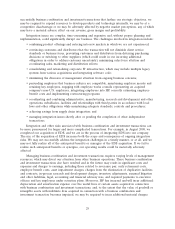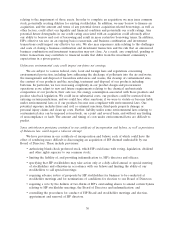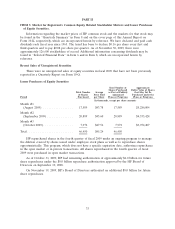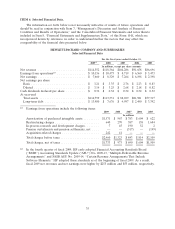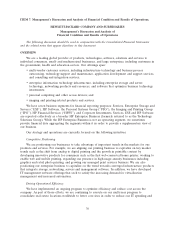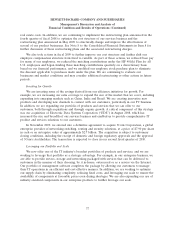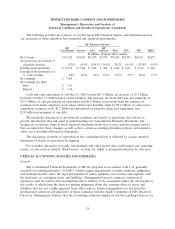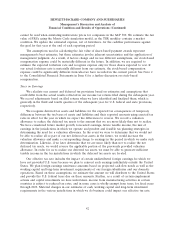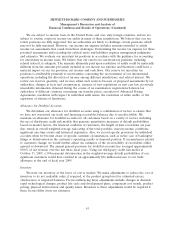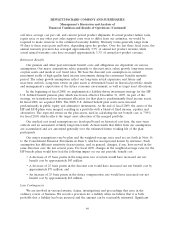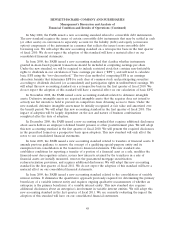HP 2009 Annual Report Download - page 46
Download and view the complete annual report
Please find page 46 of the 2009 HP annual report below. You can navigate through the pages in the report by either clicking on the pages listed below, or by using the keyword search tool below to find specific information within the annual report.HEWLETT-PACKARD COMPANY AND SUBSIDIARIES
Management’s Discussion and Analysis of
Financial Condition and Results of Operations (Continued)
reasonable; however, actual results may differ from these estimates under different assumptions or
conditions.
An accounting policy is deemed to be critical if it requires an accounting estimate to be made
based on assumptions about matters that are highly uncertain at the time the estimate is made, if
different estimates reasonably could have been used, or if changes in the estimate that are reasonably
possible could materially impact the financial statements. Management believes the following critical
accounting policies reflect the significant estimates and assumptions used in the preparation of the
Consolidated Financial Statements.
Revenue Recognition
We enter into contracts to sell our products and services, and, while the majority of our sales
agreements contain standard terms and conditions, there are agreements that contain multiple elements
or non-standard terms and conditions. As a result, significant contract interpretation is sometimes
required to determine the appropriate accounting, including whether the deliverables specified in a
multiple element arrangement should be treated as separate units of accounting for revenue recognition
purposes, and, if so, how the price should be allocated among the elements and when to recognize
revenue for each element. We recognize revenue for delivered elements only when the delivered
elements have standalone value, uncertainties regarding customer acceptance are resolved and there are
no customer-negotiated refund or return rights for the delivered elements. If the arrangement includes
a customer-negotiated refund or return right relative to the delivered item and the delivery and
performance of the undelivered item is considered probable and substantially in our control, the
delivered element constitutes a separate unit of accounting. Changes in the allocation of the sales price
between elements may impact the timing of revenue recognition but will not change the total revenue
recognized on the contract.
We recognize revenue as work progresses on certain fixed-price contracts, such as consulting
arrangements. Using a proportional performance method, we estimate the total expected labor costs in
order to determine the amount of revenue earned to date. We follow this basis because reasonably
dependable estimates of the labor costs applicable to various stages of a contract can be made. Total
contract profit is subject to revisions throughout the life of the contract. We record changes in revenue
to income, as a result of revisions to cost estimates, in the period in which the facts that give rise to the
revision become known.
We recognize revenue on certain design and build (design, development and/or construction of
software and/or systems) projects using the percentage-of-completion method. We use the cost-to-cost
method of measurement towards completion as determined by the percentage of cost incurred to date
to the total estimated costs of the project. In circumstances when reasonable and reliable cost estimates
for a project cannot be made, we recognize revenue using the completed contract method.
We record estimated reductions to revenue for customer and distributor programs and incentive
offerings, including price protection, promotions, other volume-based incentives and expected returns.
Future market conditions and product transitions may require us to take actions to increase customer
incentive offerings, possibly resulting in an incremental reduction of revenue at the time the incentive is
offered. Additionally, certain incentive programs require us to estimate, based on historical experience,
the number of customers who will actually redeem the incentive.
In October 2009, the Financial Accounting Standards Board (‘‘FASB’’) issued Accounting
Standards Update (‘‘ASU’’) No. 2009-13, ‘‘Multiple-Deliverable Revenue Arrangements’’
39


